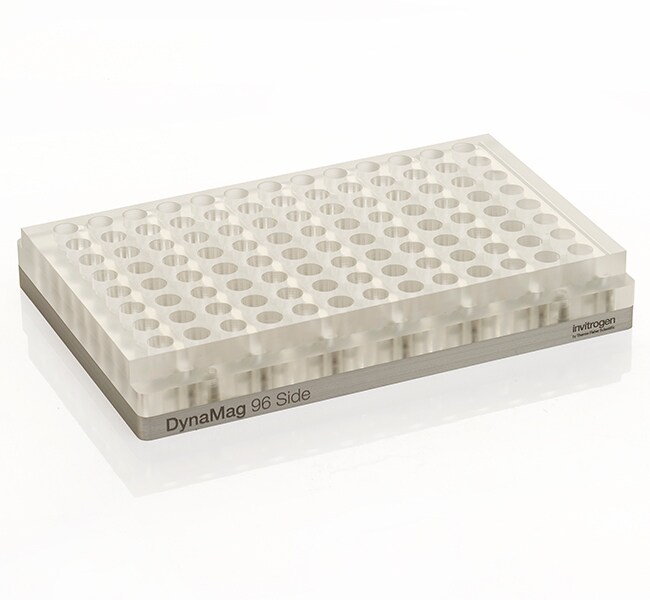Search Thermo Fisher Scientific

DynaMag™-96 Side Magnet
| Catalog Number | Quantity |
|---|---|
| 12331D | 1 Each |
Efficient mixing without sample handling
This magnet has an extra column (13 total). This enables sample mixing simply by shifting the 96-well plate back and forth from the right-most position to the left-most position. This shifting draws the beads back and forth through the sample and allows mixing to be achieved without handling, promoting faster processing and less sample handing-induced variation.
Handling volume
When used in combination with the DynaMag™-96 Bottom magnet on an automation platform, the two magnets allow for significant volume changes through a workflow.
• High wash volumes: DynaMag™-96 Side Magnet
• Low elution volumes: DynaMag™-96 Bottom magnet
Learn more about Dynabeads™ products
• Find Dynabeads™ products for a whole range of applications.
• Find other magnets for Dynabeads™ separations.
Documents & Downloads
Certificates
Product Information
Frequently asked questions (FAQs)
The DynaMag-2 Magnet is 3,500-3,700 minimum Gauss level and the DynaMag-Spin is 3,000-3,500 minimum Gauss level.
Find additional tips, troubleshooting help, and resources within our Protein Assays and Analysis Support Center.
1 Tesla is equivalent to 10,000 Gauss.
.
Spray and/or wipe the DynaMag magnet unit with one of the following cleaning agents:
- 70% (v/v) isopropyl alcohol
- 1% (v/v) sodium hypochlorite solution (bleach)
- 0.1 N HCl solution
Do not submerge the magnet unit in aqueous solutions and avoid prolonged exposure to water or aqueous solutions. Clean with a damp cloth and mild detergent when exposed to harsh solvents. Do not autoclave the magnet unit as heating the magnet to above 70 degrees C can destabilize the magnetic material, resulting in loss of magnetic strength.
The DynaMag-2 Magnet can hold 16 standard 1.5 mL or 2 mL microcentrifuge tubes, while the DynaMag-Spin Magnet holds up to 6 standard 1.5 mL microcentrifuge tubes.
Spray and/or wipe the DynaMag magnet unit with one of the following cleaning agents:
- 70% (v/v) isopropyl alcohol
- 1% (v/v) sodium hypochlorite solution (bleach)
- 0.1 N HCl solution
Do not submerge the magnet unit in aqueous solutions and avoid prolonged exposure to water or aqueous solutions. Clean with a damp cloth and mild detergent when exposed to harsh solvents. Do not autoclave the magnet unit as heating the magnet to above 70 degrees C can destabilize the magnetic material, resulting in loss of magnetic strength.
Find additional tips, troubleshooting help, and resources within our Protein Assays and Analysis Support Center.